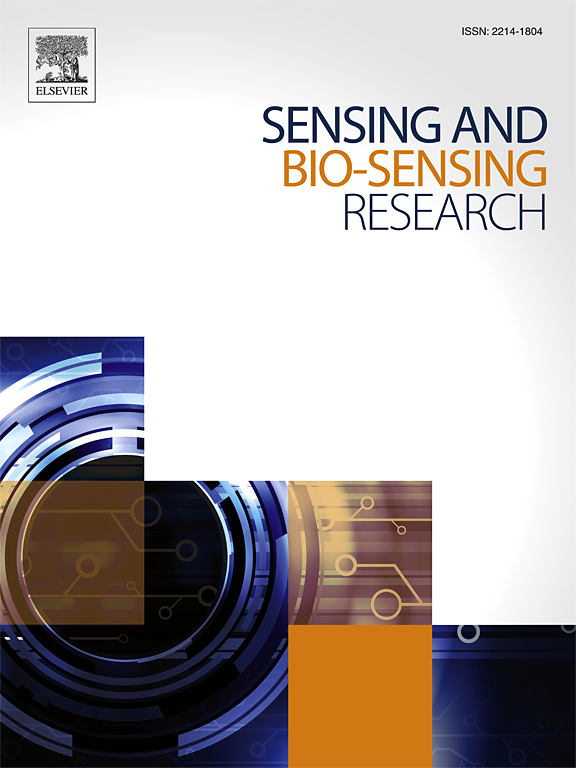Nanoengineered diagnostic surface for efficient detection of MMP1 cancer biomarkers
IF 5.4
Q1 CHEMISTRY, ANALYTICAL
引用次数: 0
Abstract
Cancer, a global health concern, necessitates improved diagnostic tools for early detection and personalized treatment strategies. Matrix Metalloproteinases (MMPs), crucial in cancer progression, degrade the extracellular matrix (ECM) and facilitate metastasis. MMP1, notable for its role in ECM degradation and tumor promotion, is implicated in various cancers. Detecting MMP1 early offers critical insights into cancer progression and treatment efficacy. Traditional diagnostic methods are invasive and time-consuming, prompting the development of more efficient detection techniques. Here, we introduce an electrochemical peptide-based biosensor for sensitive MMP1 detection. Utilizing gold nanostructures to enhance surface area and signal-to-noise ratio, the biosensor employs ferrocene-labeled peptides sensitive to MMP1 hydrolysis, enabling voltammetric detection. This approach combines nanotechnology with electrochemical techniques for enhanced sensitivity and specificity, promising transformative impacts on cancer diagnostics. The biosensor exhibits a low limit of detection (LOD) of 0.27 ng/mL and demonstrates exceptional specificity towards MMP1, highlighting its potential for precise MMP1 detection in clinical applications.
纳米工程诊断表面用于高效检测MMP1癌症生物标志物
癌症是一个全球性的健康问题,需要改进诊断工具,以便及早发现和制定个性化治疗战略。基质金属蛋白酶(MMPs)在癌症进展中起着至关重要的作用,可以降解细胞外基质(ECM)并促进转移。MMP1以其在ECM降解和肿瘤促进中的作用而闻名,与多种癌症有关。早期检测MMP1为癌症进展和治疗效果提供了关键的见解。传统的诊断方法是侵入性的和耗时的,促使更有效的检测技术的发展。在这里,我们介绍了一种基于电化学肽的生物传感器,用于灵敏的MMP1检测。利用金纳米结构来提高表面积和信噪比,生物传感器采用二茂铁标记的对MMP1水解敏感的肽,实现伏安检测。这种方法结合了纳米技术和电化学技术,提高了灵敏度和特异性,有望对癌症诊断产生变革性影响。该生物传感器的低检测限(LOD)为0.27 ng/mL,并对MMP1表现出卓越的特异性,突显了其在临床应用中精确检测MMP1的潜力。
本文章由计算机程序翻译,如有差异,请以英文原文为准。
求助全文
约1分钟内获得全文
求助全文
来源期刊

Sensing and Bio-Sensing Research
Engineering-Electrical and Electronic Engineering
CiteScore
10.70
自引率
3.80%
发文量
68
审稿时长
87 days
期刊介绍:
Sensing and Bio-Sensing Research is an open access journal dedicated to the research, design, development, and application of bio-sensing and sensing technologies. The editors will accept research papers, reviews, field trials, and validation studies that are of significant relevance. These submissions should describe new concepts, enhance understanding of the field, or offer insights into the practical application, manufacturing, and commercialization of bio-sensing and sensing technologies.
The journal covers a wide range of topics, including sensing principles and mechanisms, new materials development for transducers and recognition components, fabrication technology, and various types of sensors such as optical, electrochemical, mass-sensitive, gas, biosensors, and more. It also includes environmental, process control, and biomedical applications, signal processing, chemometrics, optoelectronic, mechanical, thermal, and magnetic sensors, as well as interface electronics. Additionally, it covers sensor systems and applications, µTAS (Micro Total Analysis Systems), development of solid-state devices for transducing physical signals, and analytical devices incorporating biological materials.
 求助内容:
求助内容: 应助结果提醒方式:
应助结果提醒方式:


